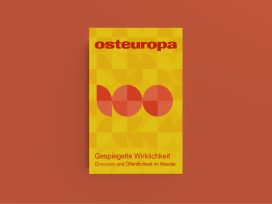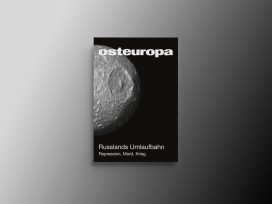The Europe beyond Europe
Europe is a strange phenomenon that is difficult to grasp. It is easier to nail jelly to the wall than to find an accurate definition of Europe. Europe cannot be characterized in clear-cut terms, but rather by paradoxes and polar opposites: unity and diversity, expansion and distension, consolidation and enlargement. Behind each individual Europe lies a different version of the continent. The political Europe of the European Union has been moulded out of cultural Europe, although at the same time, cultural Europe is larger than political Europe. The functional Europe, which is concerned with security and cooperation, extends beyond the cultural and geographical boundaries of Europe: The OSCE includes among its members both the United States and the countries of Central Asia.
The eastern enlargement of the European Union in 2004 has proved how impossible it is to bring these many different Europes into line with each other. For this reason, the seeds of failure had already been sown even as Europe celebrated its greatest success. Almost as soon as an institutional entity had been created after a decade and a half of hard work – something that could only have been dreamed of during the 40 years of division between East and West – cracks started to appear, cracks that, even in 2007, could be papered over only with great effort. The list of catchwords here includes the war in Iraq, old Europe, and the constitutional crisis. It has also become clear that the eastern enlargement was only a partial one, and that countries unquestionably interwoven into cultural and functional Europe remain outside the gates of Europe in political terms.
In this way, despite invocations of “finality”, the debate continues to revolve around two central “border issues”: Where should the outer borders of political Europe run, and where are the inner limits of supranational integration? The smaller the circle of members of the institution, the more homogeneous their interests and views, and the easier it is to reach a decision. However, it is also ineffective to the same degree. It would be easier for the Benelux countries to reach agreement on a foreign and security policy that could accurately be labelled “common” than it is for 27 EU member states. However, this ease of passage would in no way compensate for the loss of significance that a restriction of this nature would entail. The membership of Uzbekistan and Turkmenistan in the OSCE severely undermines the aspirations of the organization to promote human rights. Even so, would it be appropriate to reject all possibilities of exerting influence simply for the sake of maintaining credibility? The reverse applies, in that the larger the circle of members, the more difficult it is to reach a decision. However, it can be all the more effective as a result. The common market is primarily attractive because it is home to 450 million people. The degree of effectiveness with which the Union is able to act depends on how precisely the mechanisms for reaching decisions are tailored towards reaching a majority, although this increases the risk of factual issues being turned into power politics. That said, the greater the desire to represent all interests, the weaker the EU becomes.
In both “border issues”, political Europe has decided to give itself pause for thought. The European Neighbourhood Policy, which includes the “European neighbours” in eastern Europe and the “neighbours of Europe” in the Mediterranean area, is designed primarily to deter entry ambitions, which are harboured chiefly by Ukraine and Moldova, rather than to prepare these countries for entry. The negotiation of a new partnership agreement with Russia, which is aimed at making the eastern border of the EU more permeable, has been put on ice as a result of the discord between Moscow and Warsaw. The use of the double majority in the EU has been postponed until at least 2014.
This pause for thought should not be interpreted as stagnation. It must be regarded as an opportunity to discover the Europe beyond Europe. The outer borders that mark the end of Europe in textbooks and political speeches must be overcome. It is necessary to stop at the inner borders, which are allegedly no longer there, and consider the uniqueness of what has been preserved amid all the unification. Finally, efforts must be made to oppose the establishment of artificial borders on our mental map of Europe.
All this is reflected in the credo of Osteuropa, which is dedicated to pluralism of disciplines, interest in knowledge, approaches, methods, and theories. The journal consciously resists the trend towards specialization that threatens the dialogue between disciplines, between academic debate and the general public, and between West and East. The anthology “The Europe beyond Europe” is the second publication for English-language readers after “Sketches of Europe”, which was produced in 2005 for the World Congress on Eastern European Research. Like its predecessor, this issue also combines thematic unity with a diversity of insights.
Karl Schlögel (Berlin), for example, approaches the subject of Europe in a very individual and highly fruitful manner. He sees, hears, smells, and feels Europe. During his travels, he stops in both the major political centres and the less well-known European hubs, discovering on the ground those aspects of life that remain ignored from the perspective of the high towers of academic research, and brings together the consequences of acceleration on the high-speed routes with the resistance to change in Belarus, the “black hole” of Europe.
Regine Dehnel (Hanover) und Dorothea Redepenning (Heidelberg) take a look at Europe from its low point: its destruction. The National Socialist policy of annihilation, which was directed in particular against the Jews and the Slavic peoples of eastern Europe, aimed to obliterate their cultural heritage. Works of art and cultural artefacts were stolen and disappeared, remaining lost to this day. The deliberate destruction of cultural artefacts is a moral burden, the political consequences of which are to be felt in today’s Europe. Redepenning shows how the genocide of European Jews perpetrated by the National Socialists triggered a search for a musical language across the entire continent. In this way, music becomes a vehicle for European remembrance.
Three authors demonstrate how the rifts caused by the explosion of violence in the first half of the twentieth century are being bridged politically today. Georg Vobruba (Leipzig) shows how the European Union aims to export security, democracy, and rule of law beyond its borders, without relocating its borders in the process. As Arkady Moshes (Helsinki) explains, the chief beneficiary of this procrastination is Russia, which has not relinquished its claim to being a stand-alone power in Europe’s east. One of the neuralgic points in the competition for integration in eastern Europe between Brussels and Moscow is energy policy, as Kirsten Westphal (Giessen) shows.
These transnational studies are supplemented by case studies and international comparisons. Jirí Vykoukal (Prague) combines the history of ideas with institutional analysis and examines how the national movements in eastern and central Europe pursued entirely different goals under the auspices of the term “central Europe”. These differences have quickly re-emerged after they appeared to have been forgotten for a brief historical moment under the Soviet hegemony during the second half of the twentieth century. It is because of these differences that the Visegrád Group remained nothing more than a loose consultation body. Lev Gudkov (Moscow) demonstrates that Russia, which appears to be stable, is in fact in the throes of a crisis in its system. It is degenerating into a corrupt police state, with the population descending into poverty and the country becoming increasingly isolated.
Dmitrii Furman (Moscow) shows that this finding applies equally to the authoritarian regimes in Central Asia and in the southern Caucasus. They all imitate democracy, but are dysfunctional in terms of their legitimacy and their socioeconomic capability, bearing the seeds of their own demise. What follows in their wake will not necessarily be democracy, however. This is what sets the post-Soviet autocracies apart from the populist Polish government that has been in power since 2005. Klaus Bachmann (Warsaw) explains in his generic case study how the populists target the weak points of Polish transformation without being able to keep their promises. Ultimately, they are thus involuntarily contributing to the strengthening of democracy. The anthology is rounded off by a classic example of comparative work, in which Britta Schmitt (Hamburg) goes in search of a very different Europe beyond Europe. She shows how the prostitution policies of Europe’s countries are influenced by different ethical and religious roots. These states react very differently to the transnational migration of prostitutes across Europe, one of the darker sides of Europeanization: with liberalization, the creation of taboos, or criminalization. Here, too, we see both unity and diversity.
Manfred Sapper, Volker Weichsel, Andrea Huterer
Published 21 August 2007
Original in German
Translated by
Anna Güttel
First published by Osteuropa Special issue
Contributed by Osteuropa © Osteuropa Eurozine
PDF/PRINTNewsletter
Subscribe to know what’s worth thinking about.



